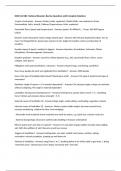EOSC114 UBC- National Disasters Review Questions with Complete Solutions
4 types of volcanoes - Answers Cinder (mafic, explosive), Shield (Mafic, non-explosive), Strato
(intermediate, felcis, mixed), Calderas (Supervolcano, felsic, explosive)
Pyroclastic flows (speed and temperature) - Answers speed: 40-400km/h ... Temp: 100-600 Degree
Celcius
Disaster scale (Volcanoes): Name, Range, Based upon - Answers VEI (Volcanic Explosivity Index). min to
max: 0 to 8 (logarithmic), based upon volume of ash, height of eruption column and duration of
eruption.
Eruption types (6 types): smallest to biggest - Answers Hawaiian, Strombolian, Volcanian, Plinian,
Ultraplinian, Phreatomagmatic (Surtseyan)
Eruption products - Answers Lava flow, fallout deposist (e.g. ash), pyroclastic flows, lahars, sector
collapse, toxic gasses
Mitigation and hazard predictions: volcanoes - Answers Hazard maps, monitoring, prediction
How many people die each year (globally) from landslides? - Answers 5000 people
How is the type of landslide determined? Based upon what? - Answers The type of material and type of
movement
Definiton: Angle of repose + is it material dependent? - Answers The steepest angle a slope can maintain
without collapsing. The angle is material dependent
Landslides: Driving and resisting forces? - Answers Driving force: gravity (sheer stress = T)... Resisiting
force: friction and cohesion (shear strenght = F_f)
External causes of landslides (5) - Answers Slope angle, undercutting, overloading, vegeation, climate
Internal causes of landslides (3) - Answers - Water content (adds weight, decrease normal force,
increase weathering, medium for flow, frost wedging)
- Inherently weak materials (some materials are weak by nature, e.g. quick clay, volcanic rocks etc)
- Adverse/bad geologic structures (unfortunate bedding or fracture orientation)
What is quick clay? and why is it special? - Answers It is clay that change sudden viscosity when adding
salt. With the addition of salt it become much less viscous
Triggers of landslides? - Answers Earthquakes, sno melt, rainfall, loud noises, vehicles, skiiing,
excavation, volcanic eruptions, jumping up and down etc.
Velocity of landslides - Answers range from 1 to 7, anything below 6 we will be able to get away. 1 being
"extremely slow" (16mm/year) and 7 being "extremely fast" (5m/sek)
, Landslide mitigation? - Answers drainage pipes, anchors (cables and bolts), movement of hazardous
material, rock barriers, retention structures, stabilization of slopes, armor/strengthen the area.
Types of lightning - Answers 1) Intracloud lightning
2) Cloud-to-air
3) Cloud-to cloud
4) Cloud-to-ground
5) Ribbon lightning (occurs with strong winds)
6) Ground-to-cloud lightning (upward lightning)
7) Chain lightning
What is the primary lightning? - Answers The first one, and the only one that can have branches
What is a stepped later and upward streamer? - Answers The upward going electrical upward streamer
and the down going stepped later, reach each other. The result is lightning (electric recharge). There will
often we several upward streamers, but only one will connect to a stepped later.
Where in the thunderstorm will der there positive and negative charge - Answers Positive charge is
found at the top of the thunderstorm (anvil), and the negative is in the bottom.
Why do we get lightning? - Answers Because there is a build up og positive and negative charge in the
top and bottom of the thunderstorm respectively
Are there more negative or positive strikes? - Answers More negative since these come from the base of
the cloud. Positive strikes (from the anvil) are less frequent, but much stronger
Where do we have most lightning? - Answers Most lightnings in N-America is Florida, Central Africa is
the place in the world with the most lightnings (more than 50flashes/sq.km/year)
30. sec. rule, what is it? How do we calculate distance from lightning? - Answers To find out how far
from the lightning we find outselvs, we found the amount of sec. between seeing the lightning and
hearing the thunder. Then divide by 3.
30 sec rule tells us to stay indoor if there is less than 30 sec. between flash and thunder. Because the
thunderstorm is closer than 10km
Thunderstorm morphology, draw annotate the following: anvil, updraft zone, positive/negative charge
areas, mammals, flanking line, wall could, tornado - Answers :D
Dimensions of a thunderstorm - Answers Anvil: diameter up to 100s of km
Main updraft: 15km in diamter




